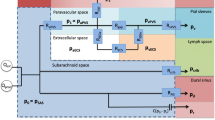Summary
Intracranial pressure (ICP) has been measured in eight patients with chronic subdural haematomas (CSH) for 24 hours prior to and for 24 hours following evacuation of the haematomas. In all patients ICP was increased prior to surgery (mean: 23 mm Hg), and it rose again to the preoperative level following evacuation of the haematomas in spite of disappearance of most symptoms and signs. In two of these patients and in another eight patients with CSH, colloid osmotic pressures were measured in samples obtained simultaneously from haematoma fluid and venous blood during surgery. The colloid osmotic pressure in haematoma fluid varied considerably between patients (lowest: 11.8 mm Hg, highest: 60 mm Hg), and thus the difference between colloid osmotic pressures in haematoma fluid and plasma also varied considerably. We suggest that the increased ICP in patients with CSH is the consequence of an increased resistance to absorption of cerebrospinal fluid due to compression of the underlying subarachnoid space. The findings with regard to colloid osmotic pressures suggest that osmotic gradients may be maintained across the boundaries of a chronic subdural haematoma.
Similar content being viewed by others
References
Becker, D. P., Young, H. F., Vries, J. K.,et al., Monitoring in patients with brain tumors. Clin. Neurosurg.22 (1975), 364–368.
Brodersen, P., Gjerris, F., Regional cerebral blood flow in patients with chronic subdural hematomas. Acta Neurol. Scand.51 (1975), 233–239.
Børgesen, S. E., Gjerris, F., Sørensen, S. C., Intracranial pressure and conductance to outflow of cerebrospinal fluid in normal-pressure hydrocephalus. J. Neurosurg.50 (1979), 489–493.
Gaab, M., Pflughaupt, K. W., Wodarz, R.,et al., Pathogenesis of chronic subdural hematoma: ICP, morphological and biochemical findings. Neurosurg.4 (1979), 476.
Gardner, W. J., Traumatic subdural hematoma with particular reference to the latent interval. Arch. Neurol. Psychiat.27 (1932), 847–858.
Plum, F., Posner, J. B., Diagnosis of stupor and coma, 286 pp. Philadelphia: F. A. Davis Company. 1973.
Rabe, E. F., Flynn, R. E., Dodge, P. R., A study of subdural effusions in an infant: with particular reference to their mechanisms of persistence. Neurology12 (1962), 79–92.
Tabaddor, K., ICP and compliance in chronic subdural hematoma. Neurosurg.4 (1979), 476.
Weir, B., The osmolality of subdural hematoma fluid. J. Neurosurg.34 (1971), 528–533.
Wright, E. M., Active transport of glycine across the arachnoid membrane. Brain Res.76 (1974), 354–358.
Zollinger, R., Gross, R. E., Traumatic subdural hematoma: An explanation of the late onset of pressure symptoms. J.A.M.A.103 (1934), 245–249.
Zülch, K. J., Neuropathology of intracranial haemorrhage. Progr. Brain Res.30 (1968), 151–165.
Author information
Authors and Affiliations
Rights and permissions
About this article
Cite this article
Gjerris, F., Sørensen, S.C. Colloid osmotic and hydrostatic pressures in chronic subdural haematomas. Acta neurochir 54, 53–60 (1980). https://doi.org/10.1007/BF01401943
Issue Date:
DOI: https://doi.org/10.1007/BF01401943




